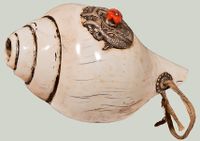Conch: Difference between revisions
Jump to navigation
Jump to search
No edit summary |
No edit summary |
||
| Line 2: | Line 2: | ||
'''Conch''', '''White Conch''' or '''Dungkar''' (Skt. shankha [[Wyl.]] ''dung dkar'', Tib. ''Dungkar'') - a large white seashell which was used in Indian religious ceremonies, and also warfare, and was hence adopted in tantric Buddhist rituals. Usually one plays in a pair in which the musicians alternate in taking breath, to ensure the continuity of the sound. | '''Conch''', '''White Conch''' or '''Dungkar''' (Skt. shankha [[Wyl.]] ''dung dkar'', Tib. ''Dungkar'') - a large white seashell which was used in Indian religious ceremonies, and also warfare, and was hence adopted in tantric Buddhist rituals. Usually one plays in a pair in which the musicians alternate in taking breath, to ensure the continuity of the sound. | ||
Out of the [[four activities|four enlightened activities]], the conch is related to pacifying. | |||
[[Category:Musical Instruments]] | [[Category:Musical Instruments]] | ||
Revision as of 10:15, 13 December 2016

Conch, White Conch or Dungkar (Skt. shankha Wyl. dung dkar, Tib. Dungkar) - a large white seashell which was used in Indian religious ceremonies, and also warfare, and was hence adopted in tantric Buddhist rituals. Usually one plays in a pair in which the musicians alternate in taking breath, to ensure the continuity of the sound.
Out of the four enlightened activities, the conch is related to pacifying.